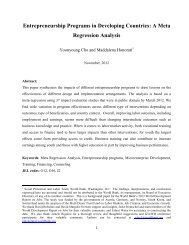Download - Youth Economic Opportunities
Download - Youth Economic Opportunities
Download - Youth Economic Opportunities
- No tags were found...
You also want an ePaper? Increase the reach of your titles
YUMPU automatically turns print PDFs into web optimized ePapers that Google loves.
Trina R. Williams Shanks, Lewis Mandell, and Deborah Adams While nearly three-fourths of the parents had a bank account, few had anyinvestment products such as retirement accounts, stocks, bonds, or certificates ofdeposit. CDAs represented the parents’ first real opportunity to accumulate assets fortheir children’s future development, as most were only modestly integrated intothe financial mainstream.These findings suggest the need for both financial education and access tofinancial products and services that are structured and incentivized to be trulyinclusive of the low-income parents of preschool children. The researchers notethat this approach would be consistent with emerging theory on financial capability,which is thought to require both financial knowledge and access to financialservices.Part of the research on CDAs for preschool families included a quasi-experimentaldesign that was conducted at the largest of the community-based SEEDprograms. Sixty-two percent of the parents in the treatment group who completeda baseline survey took the opportunity to open a CDA, with an initial deposit fromthe program for their preschool-age children. 21 Approximately 31 percent of theCDAs opened by parents who consented to participate in account monitoringresearch received additional deposits from parents or others on behalf of the childrenwithin the first four years of the program. 22 The CDAs of this SEED programwere established as state 529 plans, special tax-favored investment accounts forhigher education.A research survey conducted at this large preschool program revealed thatSEED had a positive impact on the importance parents attached to a college education.23 However, CDAs otherwise had little impact on the social and psychologicaloutcomes of interest. Furthermore, a substantial percentage of account holdersdid not deposit any funds of their own. In contrast, the program did have a smallpercentage of high savers, who tended to be White, have a higher level of education,have higher incomes, and be banked.There is one additional noteworthy finding. SEED CDAs established for thepreschool children had initial deposits of $800 from the program that were availableto parents, yet relatively few families made withdrawals, despite the difficultfinancial circumstances they faced and the length of time before their preschoolchildren would be needing the accounts to pay for postsecondary education ortraining. This indicates that the families valued the opportunity to save for theirchild’s education and resisted the temptation to dip into this account, honoring thecommitment to restrict these resources.About one-third of the parents of preschool children who were offered theseCDAs did not enroll their children in the matched savings program, which gaveresearchers the chance to conduct a qualitative study of the parents of preschoolchildren who choose not to open CDAs in the form of college savings accounts(529s). 24 They learned that most non-enrollees recalled hearing about SEED and178 innovations / <strong>Youth</strong> and <strong>Economic</strong> <strong>Opportunities</strong>
















